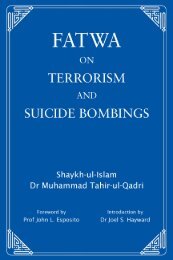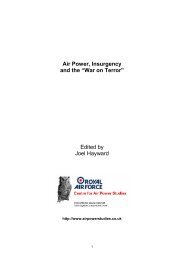Air Power, Insurgency and the âWar on Terrorâ - Prof. Joel Hayward's ...
Air Power, Insurgency and the âWar on Terrorâ - Prof. Joel Hayward's ...
Air Power, Insurgency and the âWar on Terrorâ - Prof. Joel Hayward's ...
Create successful ePaper yourself
Turn your PDF publications into a flip-book with our unique Google optimized e-Paper software.
<str<strong>on</strong>g>Air</str<strong>on</strong>g> <str<strong>on</strong>g>Power</str<strong>on</strong>g> <str<strong>on</strong>g>and</str<strong>on</strong>g> Counter-insurgency: Back to <str<strong>on</strong>g>the</str<strong>on</strong>g> Basics<br />
1960s. 511 The VNAF maintained a solid combat performance throughout <str<strong>on</strong>g>the</str<strong>on</strong>g> war. As<br />
<str<strong>on</strong>g>the</str<strong>on</strong>g> US turned <str<strong>on</strong>g>the</str<strong>on</strong>g> war over to <str<strong>on</strong>g>the</str<strong>on</strong>g> South Vietnamese, <str<strong>on</strong>g>the</str<strong>on</strong>g> VNAF took up <str<strong>on</strong>g>the</str<strong>on</strong>g> burden.<br />
In <str<strong>on</strong>g>the</str<strong>on</strong>g> spring of 1972 <str<strong>on</strong>g>the</str<strong>on</strong>g> VNAF flew thous<str<strong>on</strong>g>and</str<strong>on</strong>g>s of sorties in <str<strong>on</strong>g>the</str<strong>on</strong>g> successful air effort to<br />
defeat <str<strong>on</strong>g>the</str<strong>on</strong>g> gr<str<strong>on</strong>g>and</str<strong>on</strong>g> North Vietnamese spring offensive. However, <str<strong>on</strong>g>the</str<strong>on</strong>g> history of building<br />
<str<strong>on</strong>g>the</str<strong>on</strong>g> VNAF also highlights some of <str<strong>on</strong>g>the</str<strong>on</strong>g> complexities in supporting a less developed<br />
ally. The VNAF’s biggest problems were shortages of trained pers<strong>on</strong>nel, mechanics<br />
<str<strong>on</strong>g>and</str<strong>on</strong>g> parts. While <str<strong>on</strong>g>the</str<strong>on</strong>g> VNAF had plenty of aircraft, operati<strong>on</strong>al rates were low due to<br />
a weak infrastructure. 512<br />
Coming out of Vietnam, <str<strong>on</strong>g>the</str<strong>on</strong>g> US carried out a very successful effort to build an effective air<br />
force in El Salvador during that nati<strong>on</strong>’s insurgency from 1981 to 1992. The Salvadoran<br />
<str<strong>on</strong>g>Air</str<strong>on</strong>g> Force was primarily a helicopter force for troop transport with some close support <str<strong>on</strong>g>and</str<strong>on</strong>g><br />
medevac capabilities. The effort to increase <str<strong>on</strong>g>the</str<strong>on</strong>g> size <str<strong>on</strong>g>and</str<strong>on</strong>g> effectiveness of <str<strong>on</strong>g>the</str<strong>on</strong>g> Salvadoran<br />
<str<strong>on</strong>g>Air</str<strong>on</strong>g> force, which US trainers <str<strong>on</strong>g>and</str<strong>on</strong>g> advisors made possible, gave <str<strong>on</strong>g>the</str<strong>on</strong>g> Salvadoran Army <str<strong>on</strong>g>the</str<strong>on</strong>g><br />
ability to quickly resp<strong>on</strong>d to rebel attacks. The provisi<strong>on</strong> of medevac helicopters raised<br />
<str<strong>on</strong>g>the</str<strong>on</strong>g> morale <str<strong>on</strong>g>and</str<strong>on</strong>g> fighting effectiveness of <str<strong>on</strong>g>the</str<strong>on</strong>g> Salvadoran Army. Finally, <str<strong>on</strong>g>the</str<strong>on</strong>g> Salvadoran <str<strong>on</strong>g>Air</str<strong>on</strong>g><br />
Force gunships provided effective close air support to ground troops. 513<br />
The El Salvador<br />
experience is a good model of doing it right.<br />
Yet <str<strong>on</strong>g>the</str<strong>on</strong>g> US <str<strong>on</strong>g>Air</str<strong>on</strong>g> Force’s new counter-insurgency doctrine, <str<strong>on</strong>g>Air</str<strong>on</strong>g> Force Doctrine Document<br />
2-3, Irregular Warfare (August 2007), draws little <strong>on</strong> <str<strong>on</strong>g>the</str<strong>on</strong>g> historical experience of past US<br />
success in counter-insurgency <str<strong>on</strong>g>and</str<strong>on</strong>g> focuses instead <strong>on</strong> highlighting how <str<strong>on</strong>g>the</str<strong>on</strong>g> USAF can<br />
fight insurgents in its 94 pages. The vital missi<strong>on</strong> of training <str<strong>on</strong>g>the</str<strong>on</strong>g> host nati<strong>on</strong> air forces to<br />
fight <str<strong>on</strong>g>the</str<strong>on</strong>g>ir own war is hardly menti<strong>on</strong>ed. When <str<strong>on</strong>g>the</str<strong>on</strong>g> missi<strong>on</strong> is menti<strong>on</strong>ed <strong>on</strong> a few pages,<br />
it is discussed <strong>on</strong>ly in <str<strong>on</strong>g>the</str<strong>on</strong>g> most general terms. In c<strong>on</strong>trast, <str<strong>on</strong>g>the</str<strong>on</strong>g> new Army <str<strong>on</strong>g>and</str<strong>on</strong>g> Marine<br />
Corps counter-insurgency doctrine c<strong>on</strong>tains a more detailed discussi<strong>on</strong> c<strong>on</strong>cerning<br />
<str<strong>on</strong>g>the</str<strong>on</strong>g> requirements for building indigenous air forces. Although all <str<strong>on</strong>g>the</str<strong>on</strong>g> major counterinsurgency<br />
<str<strong>on</strong>g>the</str<strong>on</strong>g>ories of <str<strong>on</strong>g>the</str<strong>on</strong>g> last five decades emphasise building <str<strong>on</strong>g>the</str<strong>on</strong>g> host nati<strong>on</strong> forces<br />
<str<strong>on</strong>g>and</str<strong>on</strong>g> capabilities as a key to success, <str<strong>on</strong>g>the</str<strong>on</strong>g> US military tends to ignore this. Currently <str<strong>on</strong>g>the</str<strong>on</strong>g><br />
USAF has <strong>on</strong>ly a small force of less than 300 pers<strong>on</strong>nel to cover <str<strong>on</strong>g>the</str<strong>on</strong>g> worldwide missi<strong>on</strong> to<br />
training allied nati<strong>on</strong> air forces. In c<strong>on</strong>fr<strong>on</strong>ting counter-insurgency today, all <str<strong>on</strong>g>the</str<strong>on</strong>g> services<br />
need to revamp <str<strong>on</strong>g>the</str<strong>on</strong>g>ir doctrine to place c<strong>on</strong>siderably more effort into <str<strong>on</strong>g>the</str<strong>on</strong>g> training <str<strong>on</strong>g>and</str<strong>on</strong>g><br />
advisory missi<strong>on</strong>. I can think of few US efforts that have paid off more h<str<strong>on</strong>g>and</str<strong>on</strong>g>somely at<br />
relatively little expense in manpower <str<strong>on</strong>g>and</str<strong>on</strong>g> equipment.<br />
Appropriate Equipment for Allied Nati<strong>on</strong>s<br />
The Army/Marine counter-insurgency doctrine is far superior to <str<strong>on</strong>g>the</str<strong>on</strong>g> new <str<strong>on</strong>g>Air</str<strong>on</strong>g> Force<br />
doctrine in its discussi<strong>on</strong>s about equipping host nati<strong>on</strong> air forces. FM 3-24 recommends<br />
<str<strong>on</strong>g>the</str<strong>on</strong>g> use of inexpensive, low-tech aircraft <str<strong>on</strong>g>and</str<strong>on</strong>g> technology for less developed allies facing<br />
220<br />
<str<strong>on</strong>g>Air</str<strong>on</strong>g> <str<strong>on</strong>g>Power</str<strong>on</strong>g>, <str<strong>on</strong>g>Insurgency</str<strong>on</strong>g> <str<strong>on</strong>g>and</str<strong>on</strong>g> <str<strong>on</strong>g>the</str<strong>on</strong>g> “War <strong>on</strong> Terror”





